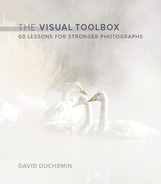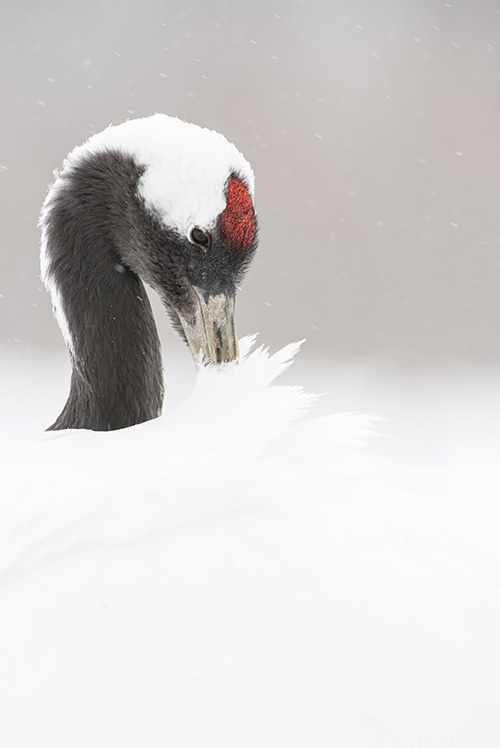Lesson 40. Understand Visual Mass
Every element in the frame exerts a certain amount of pull on the eye of the reader. Our eyes, and by that I really mean our brains, our attention, are drawn to some things over other things. Elements that pull the eye are said to have visual weight, or mass. Understanding this, and playing with it, is key to almost any further conversation about composition. You can’t, for example, talk about balance without talking about the relative visual pull of the elements in the frame. Of all the concepts I ever wrapped my mind around in photography, this one has made the greatest difference to me.
Some things pull at our attention more than others. As an example, generally speaking our eyes are pulled by larger objects before small ones, moving objects before stationary ones, bright before dark, sharp before blurred, human or organic before inorganic, and so on. There’s no definitive list because it all changes with context. A white pebble in a sea of black sand will potentially draw the eye as much as a black pebble in a sea of white sand. In this case it’s not about whether the pebble is black or white, but the contrast. Similarly, a man blurred by motion in an otherwise static scene might exert great pull on our eyes, but no more than, say, a stationary man in crowd of moving, blurred people.

Nikon D800, 600mm, 1/2500 @ f/5.6, ISO 400
Every element in the frame pulls the eye with greater or lesser force. Where does your eye go? What path does it follow? Why? How does the first image differ from the second?
It is this ever-changing context that makes it hard to be definitive, but the principle is what matters, not a memorized list. Photographers are observers, and you should be able to come up with your own. It is understanding and noticing visual mass that makes the difference.
How can you use this understanding? If you have a sense of what will pull the eye you can more intentionally choose what you include or exclude from the frame. If you know that the eye finds diagonal lines more dynamic than parallel lines, you can shift your perspective to make those parallel lines diagonal, changing the potential energy in the frame. If you know the eye tries to balance one element against another, and won’t stop moving around the frame until it does, you can play one visually massive element against another and extend the experience of the viewer. Or conversely, you can eliminate that tension, make a composition that’s more static, and thus create a more serene experience.
Photographs are not taken. They are made. And we are the makers. We have the ability through our optics and our choice of perspective and proximity to exert control over the way elements relate both to each other and to the frame. Being conscious of visual mass will help us make those decisions, giving us a greater sense of how the final photograph will be experienced by others.
Here are the short notes on visual mass:
• Every element in the frame will exert a measure of pull on the eye. Elements with greater pull are said to have greater mass or weight.
• Balance is an issue of weight, as is tension, so understanding visual mass will help you fine-tune the balance in your image.
• Tension is created when we create competition between elements by assigning similar visual weight to them, creating a dynamic viewing experience.
• Visual weight is not only about composition but about message. Making a significant element larger, brighter, sharper, and so forth will make it dominant. Is that what you want? Is there a way to tone that down or exaggerate it? We point with our photographs, saying, in essence, “Look at this.” Giving elements greater weight is a way of saying “Look at this,” more specifically.
• Visual mass can be used in the digital darkroom as well. Subtly sharpening or blurring elements creates either a push or a pull on the eye. The same goes for dodging and burning, or even changes in the crop.
“Of all the concepts I ever wrapped my mind around in photography, understanding visual mass has made the greatest difference to me.”

